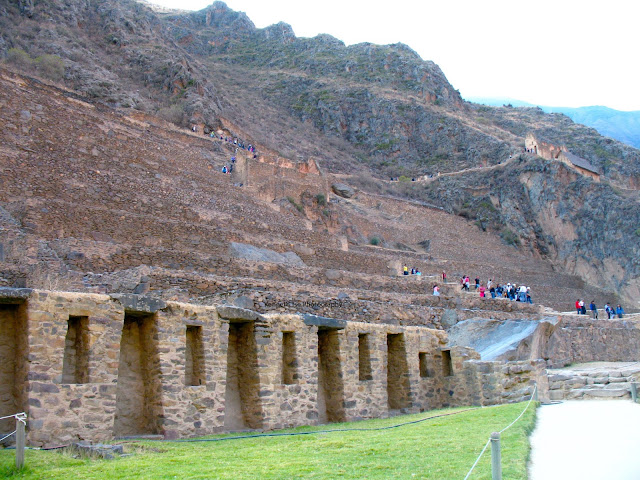I was instructed to meet at the fountain at Plaza de Armas at 8:40pm to meet the tour guide, but decided to go to the square early to take some morning photos of the square. Little did I know one of the highlight on my trip was about to unfold unexpectedly.
At about 7:30am, commotion started to surround Iglesia De La Compania De Jesus.
People started to pour out of the church with religious banners.
There were men and women dressed in highly decorated cultural costumes but only the men carry stuffed baby llamas on their back and wore white masks. I couldn't tell if the stuffed baby llamas were made from real skin or not.
There was also a live llama, assumed to be the mascot, herded by children.
Other participants were less adorned but just as colourful. The rainbow is a symbol of prosperity to the Quechua as it is closely associated with rain, the bringer of growth and life. The procession danced joyously around the plaza, the bells on their costume jiggled as they threw their whip around.
The procession then gathered at the main squared and cleared a center space where individual dancers threw their whip in an animated fashion.
The youths carry on the tradition.
The leader of the procession (I assume) stated to address the crowds.
He was a mighty man. I especially love this shot of him with the golden statue of the Incan king above his shoulder.
I still do not know what was celebrated, but I suspect that it was related to the Quechua's New Year (Aug 1). I would have loved to stay and watch much more, but unfortunately, it was 8:30am and my tour of Scared Valley awaited.
Our first stop was a small roadside market with some colourful souvenirs. I needed a warmer touque for the trek and purchased a double layered touque for 10 soles. It was a pretty good price.
An hour later, we arrived at the ruins of Inca Pisac. There were farming terraces typical of Incan cities, and temples, quarter for the king, ceremonial altar and school for royals can be found at the very top..
Meanwhile, farmers lived in a separate area above the farming terraces on another hill.
Today, Peruvian farmers settle in the valley instead.
Because a single standard frame couldn't show the whole landscape...
The tour then continued to a silver workshop (tourist trap) and a restaurant for buffet lunch (good but nothing too memorable) before another 1 hour ride until we arrive at Ollantaytambo. Ollantaytambo is Incan city where construction was not complete.
This is my worst nightmare...congestion of tourists and tour groups. But I can't really complain as I contribute to the issue...
These alpacas had ear tags and I was told they were put here to make the area more "authentic".
Across the farming terraces on the opposite hill were other ruins, mostly storage buildings where the Incas store enough food and material to last 3 years of adversities.
Because a single standard frame couldn't show the whole landscape...
Ollantaytambo deserves a whole day. I wish I had the time. The complex was pretty large with lots of areas to explore.
As we returned to the tour bus, two children boarded and sang a song hoping for tips.
We finally arrived at Chinchero by dusk.
The last stop was a demonstration of traditional wool dyeing. It felt like a tourist trap as well.
After the cultural festival in the morning, the tour of Sacred Valley seemed to lack lustre. Perhaps it is the unbelievable number of tourists at each site that puts me off. I wish to have the chance to visit again in the future in a more relaxed and less crowded fashion.
My trekking guide, Hugo, arranged to pick me up at 5am the next morning to begin our Salkantay hike. It was an early night to bed immediately after another chicken soup dinner.

































